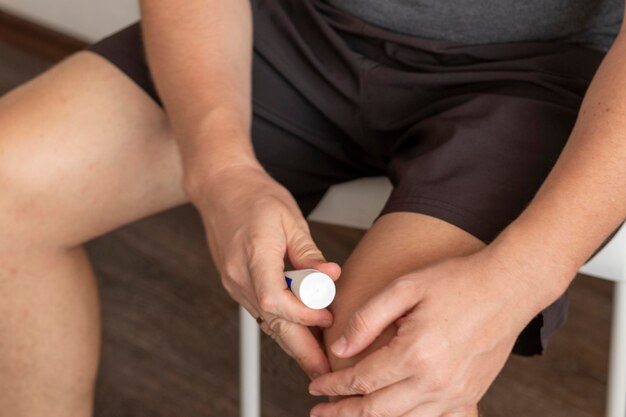Understanding Arthritis Testing: Methods, Steps, and Next Actions
Arthritis, a condition affecting millions worldwide, can bring discomfort and limit daily activities. If you're feeling persistent joint pain or stiffness, it might prompt you to wonder: How can you test for arthritis? Fear not! Gaining clarity on this process can empower you to navigate the path to well-being with confidence.
Recognizing the Signs: Should You Get Tested?
While occasional joint aches can be due to various factors, arthritis is marked by specific symptoms. Recognizing these early can be beneficial:
- Persistent joint pain
- Swelling or redness around joints
- Stiffness, especially in the morning
- Limited range of motion
These symptoms warrant a visit to your healthcare provider, who will guide you through the necessary next steps.
Initial Consultation: The First Step
When embarking on the journey of arthritis testing, your healthcare provider's expertise is invaluable. Here's what you can expect during an initial consultation:
Medical History Review
Your doctor will begin with a detailed medical history review, which is crucial for identifying potential risk factors and patterns. Be ready to discuss:
- Family history of arthritis
- Previous joint injuries
- Other health conditions, like autoimmune disorders
Physical Examination
A comprehensive physical examination is next. Your doctor will:
- Examine joints for swelling and tenderness
- Assess range of motion and flexibility
- Observe any redness or warmth in joints
These insights will guide the doctor in deciding if further testing is needed.
Diagnostic Tests for Arthritis
Should your symptoms and examination suggest arthritis, your doctor might recommend several diagnostic tests. Each test serves to confirm or rule out specific types of arthritis:
Blood Tests
- Rheumatoid Factor (RF): Elevated levels might indicate rheumatoid arthritis.
- Anti-CCP (Anti-Cyclic Citrullinated Peptide): More specific for diagnosing rheumatoid arthritis.
- Erythrocyte Sedimentation Rate (ESR) and C-Reactive Protein (CRP): These tests measure inflammation levels, which can suggest inflammatory arthritis.
- Antinuclear Antibody (ANA) Test: Helps in identifying conditions like lupus that can mimic arthritis symptoms.
Imaging Tests
Imaging plays a pivotal role in diagnosing arthritis, as it reveals joint structure changes:
- X-rays: Useful for detecting bone damage and loss of joint space typical in osteoarthritis.
- MRI (Magnetic Resonance Imaging): Offers detailed images of soft tissues, aiding in identifying early damage.
- Ultrasound: Helps assess inflammation and fluid in the joints and soft tissues.
Joint Fluid Analysis
Sometimes, testing joint fluid (also known as synovial fluid) is recommended:
- A sample is collected through a procedure called arthrocentesis.
- The fluid is analyzed for infection, uric acid crystals, and white blood cell count.
This test can differentiate between arthritis types, such as gout or septic arthritis.
Diverse Types of Arthritis: Tailoring Tests
Understanding that arthritis isn’t a one-size-fits-all condition is crucial. The type can affect the tests and treatments required:
Osteoarthritis vs. Inflammatory Arthritis
- Osteoarthritis (OA): Often related to wear and tear, OA primarily involves physical examinations and imaging tests to assess joint deterioration.
- Inflammatory Arthritis: Conditions like rheumatoid arthritis or psoriatic arthritis often require a combination of blood tests and imaging to gauge joint inflammation and systemic involvement.
Gout and Pseudogout
For gout diagnoses, the focus is on:
- Testing uric acid levels in blood
- Analyzing joint fluid for uric acid crystals
Pseudogout, on the other hand, involves checking for calcium pyrophosphate crystals in joint fluid.
Next Steps After Diagnosis
Upon receiving an arthritis diagnosis, the journey continues, albeit more informed. Here's what to consider:
Personalized Management Plans
Discussing a personalized management plan with your healthcare provider is essential. This plan could involve:
- Lifestyle modifications: Including exercise and dietary changes
- Medications: To manage symptoms and slow progression
- Physical therapy: To enhance mobility and strength
Monitoring and Follow-Up
Regular monitoring and follow-up appointments will be necessary to:
- Track disease progression
- Adjust treatment plans as required
- Address any concerns promptly
Leveraging Support Resources
Living with arthritis can be challenging, but support is available:
- Support groups: Connecting with others who understand your journey
- Educational resources: To stay informed about advances in arthritis care
- Professional counseling: If emotional challenges arise
Insights to Pave the Way Forward
Understanding how to test for arthritis offers a glimpse into a clearer, more informed approach to managing joint health. By recognizing symptoms, undergoing appropriate tests, and engaging in a personalized care plan, you empower yourself towards a healthier future. Let your quest for knowledge guide your path to comfort and functionality—because living well with arthritis is an attainable goal.
Key Takeaways
- 🚦 Recognize early symptoms: Persistent pain, swelling, and stiffness.
- 🩺 Consult a doctor: Review history and undergo a physical exam.
- 🧪 Diagnostic tests: Include blood tests, imaging, and joint fluid analysis.
- 🔍 Differentiate types: Osteoarthritis vs. inflammatory arthritis methods.
- 📋 Post-diagnosis: Work on a personalized plan and consistent follow-ups.
- 🤝 Support is crucial: Engage with groups and resources for guidance.
Remember, while this guide provides a thorough overview, discussions with healthcare professionals are vital in navigating and understanding arthritis testing.

Related Articles
- Are Bananas Bad For Arthritis
- Are Tomatoes Bad For Arthritis
- Can An Inflamed Nerve Cause Arthritis
- Can Arthritis Be Cured
- Can Arthritis Be Reversed
- Can Arthritis Become Septic After Infection From Injection
- Can Arthritis Cause Numbness
- Can Arthritis Cause Swelling
- Can Cracking Knuckles Cause Arthritis
- Can Cracking Your Knuckles Cause Arthritis